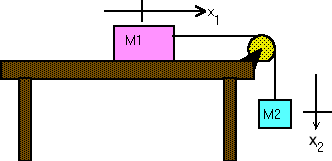Half Atwood machine with friction
A block of mass M1 is sitting on a table. There is a coefficient of static friction μs, and a coefficient of kinetic friction μk between the surface of the block and the table. The block is connected by a massless string over a massless and frictionless pulley to another block of mass M2.
(a) Draw a system schema. Include the table/pulley as one part of your system, and the string as another. Be sure to include and label all action/reaction pairs.
(b) Build free-body diagrams for each of the masses and write equations of motion for each object. Use the coordinate x1 (shown in the figure) for the position of mass M1, and x2 for the position of mass M2. How are the acceleration of M1 and M2 related?
(c) What is the largest possible mass of M2 for which the objects will not move? Explicitly state any conditions that you are using to solve the equations.
(d) With the mass M2 from (b), you give M1 a slight tap and the system starts to move. Use your equations of motion to obtain the acceleration of the two objects once they have started to move. Explicitly state any conditions that you are applying to solve the equations.
